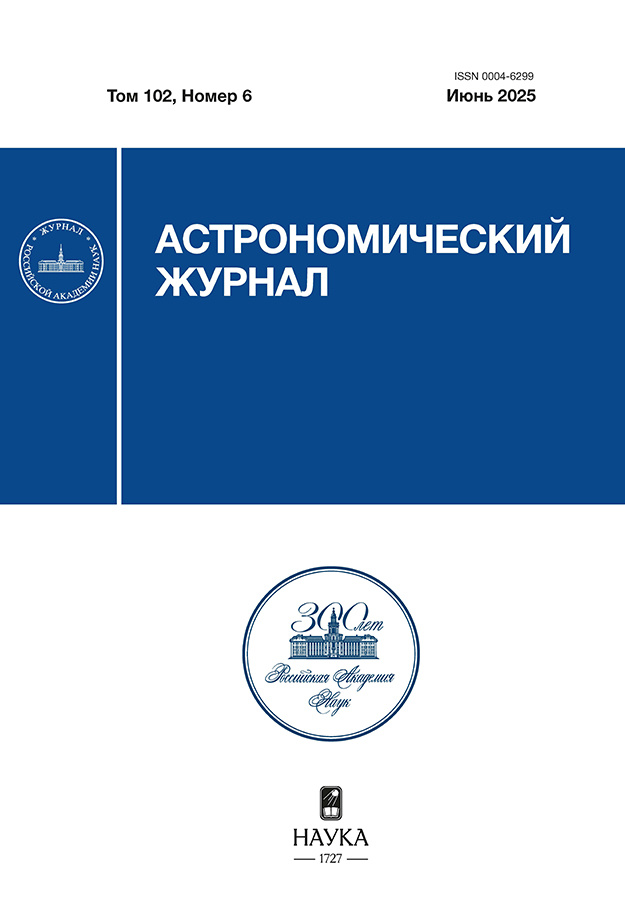Gas-dynamic instabilities in a two-dimensional boundary layer during accretion
- Authors: Aksenov A.G.1, Chechetkin V.M.1,2
-
Affiliations:
- Institute for Computer Aided Design, Russian Academy of Sciences
- Keldysh Institute of Applied Mathematics of the Russian Academy Sciences
- Issue: Vol 102, No 6 (2025)
- Pages: 468-479
- Section: Articles
- URL: https://rjeid.com/0004-6299/article/view/690671
- DOI: https://doi.org/10.31857/S0004629925060027
- EDN: https://elibrary.ru/qaqcsn
- ID: 690671
Cite item
Abstract
The purpose of the work is to build a self-consistent gas-dynamic model of the accretion disk of a compact astrophysical object, taking into account viscosity. The matter falling on a compact object consists of proton gas, electrons, and radiation arising from the braking of a rotating gas at a speed comparable to light. Physical proton viscosity is not enough in the gas-dynamic accretion model with laminar flow. It is necessary to introduce the so-called turbulent viscosity, probably arising from the development of instabilities, to explain the loss of the disk angular momentum. With a quantitative mathematical model of gas dynamics, taking into account the generally accepted turbulent viscosity, we want to demonstrate a solution with such instability. In a recently published work on Kepler disk braking, we were able to obtain only large-scale vortex structures arising from azimuthal perturbations, for example, due to tidal effects, and demonstrated an increase in disk braking against a neutron star due to these vortex structures. And the development of small-scale shear instability on the surface of a neutron star for a Kepler disk was not demonstrated in calculations. In this work, we examine a non-Keplerian disk with a non-zero negative radial velocity, ensuring the flow of matter to the surface of a compact star, as a result of which shear instability and turbulence appear.
About the authors
A. G. Aksenov
Institute for Computer Aided Design, Russian Academy of Sciences
Email: aksenov@fastmail.fm
Moscow, Russia
V. M. Chechetkin
Institute for Computer Aided Design, Russian Academy of Sciences; Keldysh Institute of Applied Mathematics of the Russian Academy SciencesMoscow, Russia; Moscow, Russia
References
- N.I. Shakura, Soviet Astron. 16, 756 (1973).
- N.I. Shakura and R.A. Sunyaev, Astron. and Astrophys. 24, 337 (1973).
- G.S. Bisnovatyi-Kogan and R.V. E. Lovelace, New Astron. Rev. 45(11–12), 663 (2001).
- G.S. Bisnovatyi-Kogan, Relativistic Astrophysics and Physical Cosmology (Moscow: KRASAND, 2011) (in russian).
- A.G. Aksenov and V.M. Chechetkin, Astron. Rep. 68(5), 438 (2024).
- Ye. P. Velikhov, A. Yu. Lugovsky, S.I. Mukhin, Yu. P. Popov, and V.M. Chechetkin, Astron. Rep. 51(2), 154 (2007).
- A. Yu. Lugovskii and V.M. Chechetkin, Astron. Rep. 56(2), 96 (2012).
- S.L. Shapiro and S.A. Teukolsky, Black holes, white dwarfs, and neutron stars: The physics of compact objects (New York: Wiley-Interscience, 1983).
- K. Nomoto and M. Hashimoto, Phys. Rep. 163, 13 (1988).
- A.G. Aksenov, A.A. Baranov, A.A. Filina, and V.M. Chechetkin, On possibility of nucleosynthesis during accretion on a compact star, KIAM Preprint № 77 (Moscow: ИПМ, 2024) (in russian), https://library.keldysh.ru/preprint.asp?id=2024-77
- L.D. Landau and E.M. Lifshits, Fluid Mechanics. Course of Theoretical Physics (New York: Pergamon Press, 1987).
- P.K. Raschewski, Riemannsche Geometrie und Tensoranalysis (Frankfurt am Main: Verlag Harri Deutsch, 1995).
- G.V. Vereshchagin and A.G. Aksenov, Relativistic Kinetic Theory (Cambridge University Press, 2017).
- A.G. Aksenov and V.M. Chechetkin, The Physics of Supernovae and Their 16 Mathematical Models (World Scientific, 2024).
- V.D. Shafranov, Rev. Plasma Physics 3, 1 (1967).
- A.G. Aksenov, V.F. Tishkin, and V.M. Chechetkin, Math. Models Computer Simulations 11, 360 (2019).
- Y.V. Artemova, G.S. Bisnovatyi-Kogan, I.V. Igumenshchev, and I.D. Novikov, 637(2), 968 (2006).
- P. Colella and H.M. Glaz, J. Comput. Phys. 59, 264 (1985).
- A.G. Aksenov, Comp. Math. and Math. Physics 55(10), 1752 (2015).
- E.P. Kurbatov, D.V. Bisikalo, and P.V. Kaygorodov, Physics Uspekhi 57(8), 787 (2014).
- N.I. Shakura and R.A. Sunyaev, Monthly Not. Roy. Astron. Soc. 175, 613 (1976).
- M.R. McKee, Astron. and Astrophys. 235(1–2), 521 (1990).
- L. Titarchuk and I. Kalashnikov, Astron. and Astrophys. 674, id. A168 (2023).
Supplementary files










